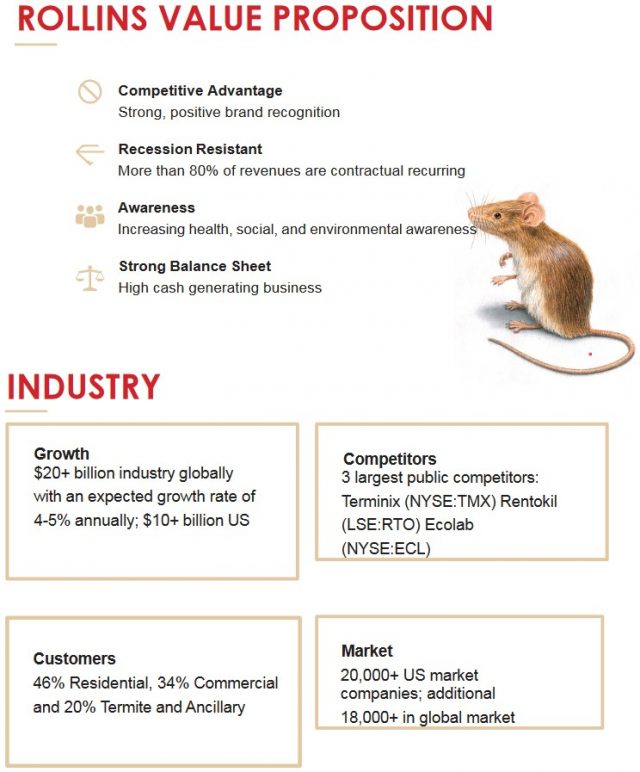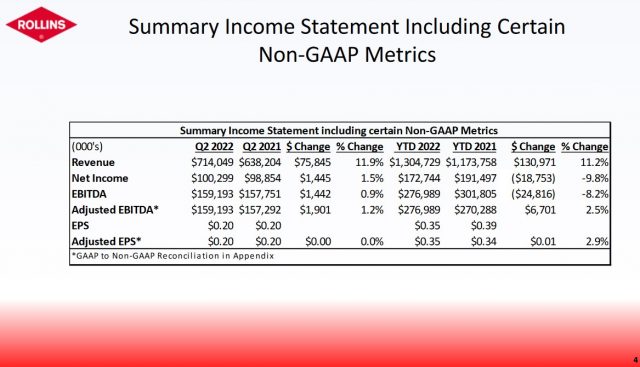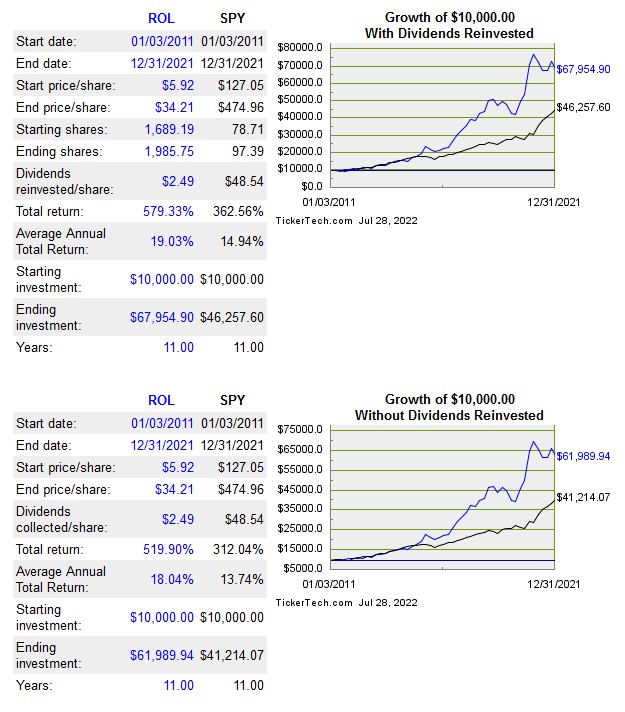Contents

In my recent CME Group – The Risk Of Relying On Stock Screeners post, I disclose that all the stock screeners I have reviewed reflect incorrect dividend metrics when a company has a special variable dividend policy. Rollins, Inc. (ROL), like CME, has a special variable dividend policy.
I last reviewed ROL in my April 30, 2022 post following the release of Q1 2022 results. I now refresh my analysis given that ROL released Q2 results on July 27.
Business Overview
In my April 30, 2022 post I provide a brief business overview.
ROL's website and Part 1 Items 1 and 1A in the FY2021 Form 10-K contain a comprehensive overview of a company which has increased revenues for 24 consecutive years.
This highly fragmented industry is experiencing high growth. ROL, being one of the largest industry participants, is well positioned to grow organically and acquire many smaller industry participants.

It has a strong acquisition pipeline with several potential opportunities being actively pursued. YTD2022, ROL has completed 22 strategic acquisitions within the U.S., United Kingdom and Australia.
Europest Environmental Services, based in Caerphilly, South Wales, United Kingdom, was acquired through a ROL subsidiary in early July 2022. ROL now has full coverage within the United Kingdom; this tuck-in transaction comes on the heels of another recent U.K. acquisition, NBC Environment, which provided ROL's first locations within Scotland.
Europest is the latest addition to the growing number of ROL companies in the UK that began with the acquisition of Safeguard Pest Control in 2016. Since then, ROL has acquired AMES Group, Kestrel Pest Control, Baroque Pest Services, the Guardian Group, Albany Environmental, Van Vynck Environmental, Enviropest, IPM and NBC Environment.
Financials
Q2 and YTD2022 Results
Please refer to ROL's Q2 2022 Form 8-K and Earnings Presentation.
Q2 and YTD2021 adjusted EBITDA is presented for comparison purposes due to the impact of a $31.5 million gain on the sale of several Clark properties (properties acquired when ROL purchased Clark Pest Control).
Fleet-related expense headwinds in Q2 are primarily attributed to a $6.8 million increase in fuel costs and a $1.7 million increase in vehicle repairs relative to Q2 2021. Fuel increases were driven by more than a 50% increase in ROL's average price paid per gallon in Q2 2021. Vehicle repairs were up due to the continued delay in the receipt of new vehicles from the manufacturers. This is forcing ROL to keep its trucks longer which leads to repairs outside of the norm.
The increase in long-term debt occurred in Q1 2021 when ROL increased its Term Loan. The purpose of this increase was to place ROL in a strong position to act quickly on either potential acquisitions or stock repurchases as opportunities may arise.
Unearned Revenue
The current portion of unearned revenue at FYE2021, Q1 2022, and Q2 2022 was ~$0.145B, ~$0.156B, and ~$0.165B. This unearned revenue represents the receipt of customer funds before the rendering of services. This is a current liability because ROL will provide services within the coming 12 months. Once the services are provided, the liability is reduced and ROL reports the appropriate revenue and related expenses on its Income Statement.
A much smaller amount is included in 'Other long-term accrued liabilities'. The majority of this is recognized over five years or less with immaterial amounts recognized through 2032.
As noted in prior ROL posts, investors need to account for this when looking at ROL's current ratio (current assets/current liabilities) and quick ratio (current assets minus materials and supplies/current liabilities).
Inclusion of Additional Metrics
The high amortization expense related to multiple acquisitions makes it impractical to value ROL based on Earnings per Share (EPS). This is because Depreciation and Amortization are such a significant component of the 'Adjustments to reconcile net income to net cash provided by operating activities' in the Condensed Consolidated Statement of Cash Flows.
Management agrees and in 2021 it started to present the following metrics:
- Earnings before interest, taxes, depreciation and amortization (EBITDA)
- Free Cash Flow
The rationale for presenting these additional metrics is to more properly illustrate ROL's strong ability to generate cash.
ROL uses the simple approach to define free cash flow, which is net cash provided by operating activities less the purchase of equipment and property.
Adjusted EBITDA
The Q2 2022 Form 8-K includes adjusted EBITDA on page 8 of 10.
Free Cash Flow (FCF)
In FY2011 - FY2021, ROL generated FCF of (in millions of $): 136, 123, 144, 165, 157, 193, 211, 272, 292, 413, and 375.
FY2022 Guidance
Management does not provide guidance. Furthermore, only 6 brokers provide FY2022 and FY2023 EPS estimates and only 2 provide FY2024 estimates.
Credit Ratings
No rating agency rates ROL's debt.
Details of ROL's debt facilities are provided in Note 9 on pages 13 and 14 of 38 in the Q1 Form 10-Q. The Q2 Form 10-Q is not yet available.
To comply with applicable debt covenants, ROL must maintain at all times a leverage ratio of not greater than 3:1. The Leverage Ratio is calculated as of the last day of the most recent fiscal quarter-end. ROL complies with this covenant at the end of Q2 2022 and expects to maintain compliance throughout FY2022.
Dividend and Dividend Yield
ROL's dividend history reflects its unique dividend policy that includes the annual distribution of a 'special dividend' just before every calendar year-end; the dividend history uses different terminology (unspecified, annual, irregular) for these special dividends under the 'frequency' column.
Looking at ROL's dividend history, ROL's regular $0.105 quarterly dividend and $0.05 special dividend distributions totalled $0.47 in 2019.
On April 28, 2020, ROL cut its quarterly dividend from $0.12/share to $0.08/share starting with the June 2020 dividend distribution. Given the uncertainty of the COVID pandemic, the company's Board deemed this dividend cut to be a prudent course of action to conserve liquidity.
The first quarterly dividend distributed in 2020 was $0.12 and the next 3 were $0.08 for a total of $0.36 in regular quarterly dividends. Unless an investor delved into the numbers, the assumption would have been that ROL cut its total annual dividend. ROL, however, distributed a $0.13 special dividend in December 2020 for a total 2020 dividend distribution of $0.49.
In 2021, ROL distributed 4 regular $0.08 quarterly dividends. Add in its $0.10 special dividend and the total dividend distribution in 2021 was $0.42.
The quarterly dividend is now $0.10. Unless something dire occurs, investors can expect $0.40 in regular dividends in 2022. ROL's YTD2022 performance has been strong and if the remainder of the current fiscal year is comparable to the first half, I envision a special dividend of at least $0.09 bringing the annual dividend distribution to the 2020 level.
If ROL distributes $0.49 in 2022, the dividend yield based on the current ~$38 share price is ~1.3%. The stock screeners I have reviewed, however, reflect ~1%.
The bulk of ROL's future total investment return is likely to continue to be predominantly in the form of capital appreciation. My rationale for investing in ROL is certainly not for dividend income.
ROL repurchased $10.7 million, $8.3 million, and $10.0 million of common stock for the years ended December 31, 2021, 2020 and 2019, respectively, from employees for the payment of taxes on vesting restricted shares.
The number of shares outstanding for the past ~8 years has been relatively stagnant at ~491 - ~492 million shares.
Stock Splits
ROL has had stock splits over the years with the most recent being a 3 for 2 stock split that was announced on October 27, 2020.
When a company initiates a stock split, the number of outstanding shares increases and the price per share decreases. However, the value of the company does not change. As a result, stock splits help make shares more affordable to smaller investors. It also provides greater marketability and liquidity in the market.
In 2012, ROL's Board authorized the purchase of up to 5 million shares of the Company’s common stock. After adjustments for stock splits, the total authorized shares under the share repurchase plan are 16.9 million shares. ROL did not purchase shares on the open market in FY2018 - FY2021. There remain 11.4 million shares authorized to be repurchased under prior Board approval.
Valuation
I typically include an EPS and adjusted EPS review when assessing a company's valuation. In some cases, however, this is not practical and is the reason why management has recently started to provide additional metrics.
ROL provides Net Cash Provided by Operating Activities (OCF) and FCF so I use these metrics to gauge its valuation.
- FY2018 - ROL generated ~$299 million and ~$272 million in OCF and FCF.
- FY2019 - ROL generated ~$320 million and ~$292 million in OCF and FCF.
- FY2020 - ROL generated ~$436 million and ~$413 million in OCF and FCF.
- FY2021 - ROL generated ~$402 million and ~$375 million in OCF and FCF.
In Q1 2022, ROL generated ~$87.5 million and ~$79.5 million in OCF and FCF.
In Q2 2022, ROL generated ~$127.3 million and ~$119.4 million in OCF and FCF.
YTD 2022, ROL generated ~$214.8 million and ~$199 million in OCF and FCF.
At the time of my last review, I conservatively estimated ROL would generate ~$360 million and ~$320 million in OCF and FCF in FY2022. Using these projections, I arrived at:
- OCF/share of ~$0.73 ($0.36B/492.3 million shares). Using the current ~$33.50 share price, the valuation based on OCF is ~46.
- FCF/share of ~$0.65 ($0.32B/492.3 million shares). Using the current ~$33.50 share price, the valuation based on FCF is ~52.
Given ROL's YTD results, I now anticipate $420 million of OCF and $400 million of FCF in FY2022. Using these projections, I arrive at:
- OCF/share of ~$0.85 ($0.42B/492.5 million shares). Using the current ~$38 share price, the valuation based on OCF is ~44.7.
- FCF/share of ~$0.81 ($0.4B/492.5 million shares). Using the current ~$38 share price, the valuation based on FCF is ~47.
The vast majority of ROL's historical total return has come from capital appreciation as opposed to dividend income; I expect the same going forward. This makes it exceedingly important to acquire shares when they are reasonably valued.
If ROL's share price were to retrace to my ~$33 June 2021 purchase price, ROL's valuation based on OCF and FCF would be:
- OCF/share of ~$0.85 ($0.42B/492.5 million shares). Using a $33 share price, the valuation based on OCF would be ~39.
- FCF/share of ~$0.81 ($0.4B/492.5 million shares). Using a $33 share price, the valuation based on FCF is ~40.7.
A ~$33 share price does not appear to be a total stretch. ROL's share price has fluctuated this past year and, at times, has been lower than when I initiated my position in June 2021.
Even at $33/share, ROL's valuation raises eyebrows. This is, however, one of the industry leaders. If we think ROL can once again double in size over the coming decade, then paying up to acquire shares does not seem to be that unreasonable. Acquiring shares at the current ~$38 share price, however, does not seem prudent and I would wait for weakness in ROL's share price.
Final Thoughts
Some investors might look at the razor-thin dividend yield and the absence of share buybacks and relegate ROL to the 'do not touch' group of companies. This could be a mistake.
To double its revenue in a decade, management determined that retaining money in the company was likely the best way to maximize long-term shareholder returns. This has proven to be a wise course of action. A $10,000 investment at the beginning of 2011, for example, has grown substantially by the end of December 2021.
This is a highly fragmented industry and ROL's financial strength positions it to be an industry consolidator.
Annual revenue in FY2011 was $1.2B and in FY2021 it was just over $2.4B. YTD2022 revenue is ~$1.305B and ~$2.6B in FY2022 revenue is not out of the realm of possibility. While ROL is growing organically, many small and mid-sized independently owned operators may be struggling in this economic environment and might be looking for an exit strategy.
On June 10, 2021, I initiated a 500-share position at ~$33.14/share in one of the 'Core' accounts within the FFJ Portfolio. It was not one of my top 30 holdings when I completed my Mid 2022 Investment Holdings Review and, for now, I am happy to just increase my exposure through the automatic reinvestment of dividends.
I wish you much success on your journey to financial freedom!
Note: Please send any feedback, corrections, or questions to [email protected].
Disclosure: I am long ROL.
Disclaimer: I do not know your circumstances and do not provide individualized advice or recommendations. I encourage you to make investment decisions by conducting your research and due diligence. Consult your financial advisor about your specific situation.
I wrote this article myself and it expresses my own opinions. I do not receive compensation for it and have no business relationship with any company mentioned in this article.



